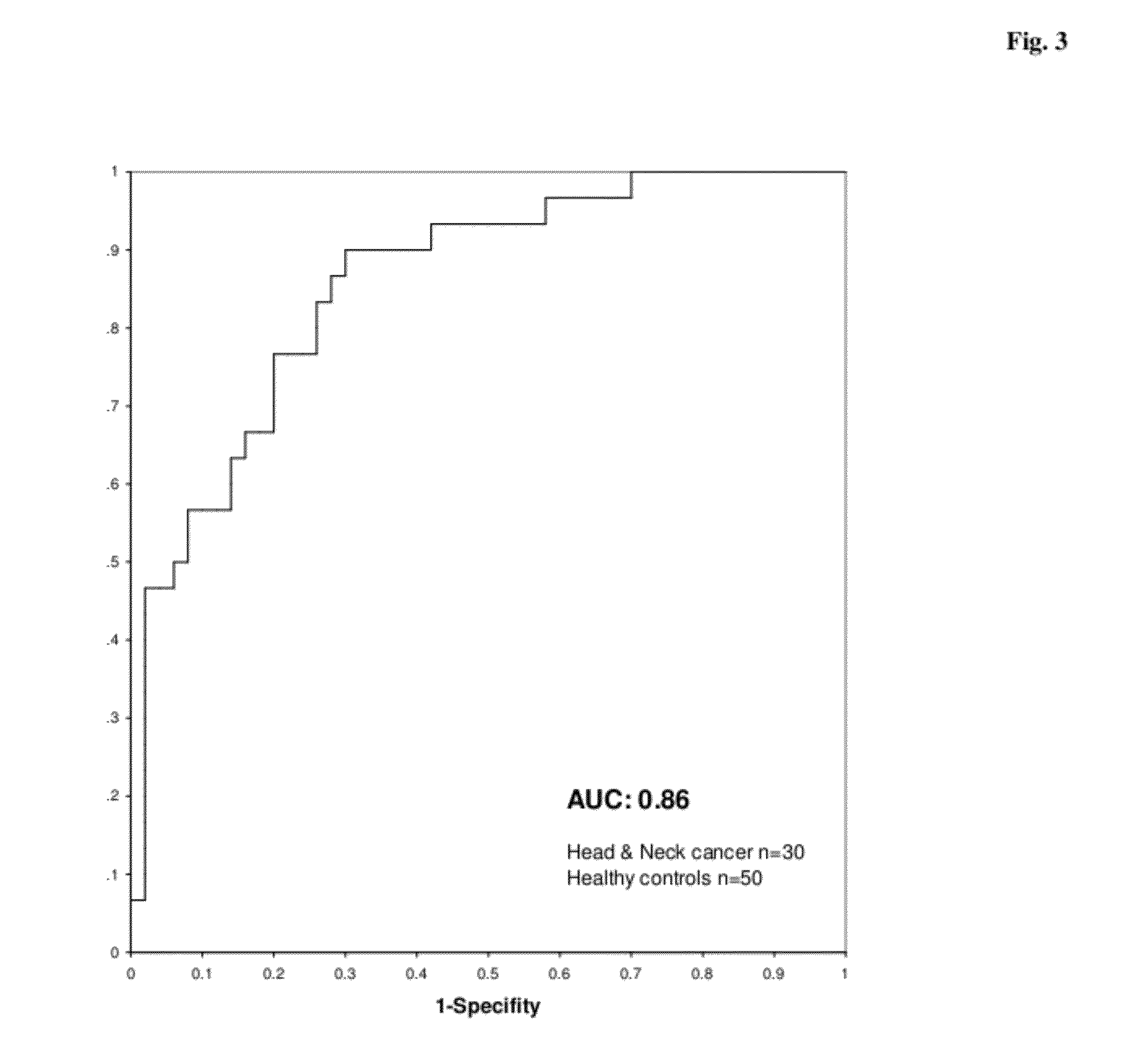Secernin-1 as a marker for cancer
a technology of secernin-1 and cancer, applied in the field of methods aiding in the assessment of cancer, can solve the problems of not meeting the criteria for sensitivity and specificity required for a screening tool, cancer remains a major public health challenge, and the cost and inability of health care systems to afford them, and achieves the effect of increasing the concentration of scrn1
- Summary
- Abstract
- Description
- Claims
- Application Information
AI Technical Summary
Benefits of technology
Problems solved by technology
Method used
Image
Examples
example 1
Identification of SCRN1 as a Potential Marker for Lung Cancer
[0181]Sources of Tissue
[0182]In order to identify tumor-specific proteins as potential diagnostic markers for lung cancer, analysis of two different kinds of tissue using proteomics methods is performed.
[0183]In total, tissue specimens from 20 patients suffering from lung cancer (LC) are analyzed. From each patient two different tissue types are collected from therapeutic resections: tumor tissue (>80% tumor) (T) and adjacent healthy tissue (N). The latter one serves as matched healthy control sample. Tissues are immediately snap frozen after resection and stored at −80° C. before processing. Tumors are diagnosed by histopathological criteria.
[0184]Tissue Preparation
[0185]0.8-1.2 g of frozen tissue are cut into small pieces, transferred to the chilled grinding jar of a mixer ball mill and completely frozen by liquid nitrogen. The tissue is pulverized in the ball mill, dissolved in the 10-fold volume (w / v) of lysis buffer (...
example 2
Generation of Antibodies Against the Cancer Marker Protein SCRN1
[0191]Polyclonal antibody to the lung cancer marker protein SCRN1 is generated for further use of the antibody in the measurement of serum and plasma levels or concentrations in other body fluids of SCRN1 by immunodetection assays, e.g., Western Blotting and ELISA.
[0192]Recombinant Protein Expression in E. coli
[0193]In order to generate antibodies against SCRN1, the recombinant antigen is produced in E. coli: Therefore, the SCRN1-encoding region is PCR amplified from a full-length cDNA clone obtained from the German Resource Center for Genome Research (RZPD, Berlin, Germany) using the following primers:
Forward primer (SEQ ID NO. 3):5′-acgtgaattcattaaagaggagaaattaactATGAGAGGATCGCATCACCATCACCATCACATTGAAGGCCGTGCTGCAGCTCCTCCAAGTTACTG-3′(EcoRI-site is underlined, coding nucleotides incapital letters).Reverse primer (SEQ ID NO. 4):5′-acgtaagcttTCATTACTTAAAGAACTTAATCTCCGTG-3′(HindIII-site is underlined, coding nucleotidesin c...
example 3
Western Blotting for the Detection of SCRN1 in Human Lung Cancer (LC) Tissue Using Polyclonal Antibody as Generated in Example 2
[0209]Tissue lysates from tumor samples and healthy control samples are prepared as described in Example 1, “Tissue preparation”.
[0210]SDS-PAGE and Western-Blotting are carried out using reagents and equipment of Invitrogen, Karlsruhe, Germany. For each tissue sample tested, 15 μg of tissue lysate are diluted in reducing NuPAGE (Invitrogen) SDS sample buffer and heated for 10 min at 95° C. Samples are run on 4-12% NuPAGE gels (Tris-Glycine) in the MES running buffer system. The gel-separated protein mixture is blotted onto nitrocellulose membranes using the Invitrogen XCell II Blot Module (Invitrogen) and the NuPAGE transfer buffer system. The membranes are washed 3 times in PBS / 0.05% Tween-20 and blocked with Roti-Block blocking buffer (A151.1; Carl Roth GmbH, Karlsruhe, Germany) for 2 h. The primary antibody, polyclonal rabbit anti-SCRN1 serum (generation...
PUM
 Login to View More
Login to View More Abstract
Description
Claims
Application Information
 Login to View More
Login to View More - R&D Engineer
- R&D Manager
- IP Professional
- Industry Leading Data Capabilities
- Powerful AI technology
- Patent DNA Extraction
Browse by: Latest US Patents, China's latest patents, Technical Efficacy Thesaurus, Application Domain, Technology Topic, Popular Technical Reports.
© 2024 PatSnap. All rights reserved.Legal|Privacy policy|Modern Slavery Act Transparency Statement|Sitemap|About US| Contact US: help@patsnap.com










